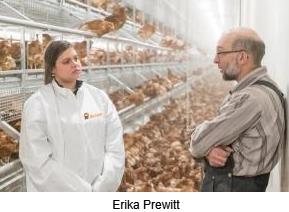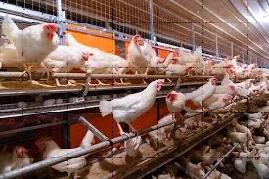 EGG-NEWS: Please share some of your background and experience with our subscribers.
EGG-NEWS: Please share some of your background and experience with our subscribers.
Erika Prewitt:
I was born and raised on a farm in central Indiana – mostly row crops and cattle. I earned a bachelor’s degree in agriculture from Eastern Kentucky University. My graduate studies were at Kansas State University, where I was awarded an MS in genetics and breeding. I served as a teacher at Southwestern Iowa College where I managed the university farm and was responsible for courses in agriculture and animal science
EGG-NEWS: When did you enter the poultry industry?
Erika Prewitt:
I was recruited by Big Dutchman in 2016 to serve in my current position.
Fortunately, I had the opportunity to be mentored by Bill Snow, an acknowledged expert in cage-free and aviary systems. He introduced me to practical aspects of rearing and egg production for aviary and barn housing. Working together with customers and applying my basic knowledge of animal science, I was able to apply both theoretical and practical information for the benefit of our customers.
EGG-NEWS: What is your contribution to Big Dutchman USA?
Erika Prewitt:
I am responsible for guidance, especially for new customers who have converted to aviary rearing and laying systems. I provide support through on-farm consultation and remote guidance as a free service to our customers. Our range extends from a typical 20,000-hen organic barn to a multi-level laying house with 300,000 birds incorporating sophisticated ventilation and lighting installations.
EGG-NEWS. What are the key areas of concentration in rearing pullets to perform to breed standard in laying aviaries?
Erika Prewitt:
I strongly believe that a good pullet is necessary for a successful laying cycle. Management and housing should be appropriate to each of the life stages of a pullet to achieve genetic potential. The design of our equipment is intended to support growth, musculoskeletal development, and flock uniformity.
Areas of concern include achieving a uniform temperature and even ventilation during brooding; ensuring that the flock returns to the aviary at night when they are released at about five weeks of age. Our lighting systems with dimmers create an artificial sundown that encourages return to the aviary with perching. The installation of ramps is necessary for young pullets to learn to move vertically between the tiers and to develop balance and agility.
EGG-NEWS: Producers appear to be concerned over the transition period from rearing to laying. Have you any observations?

Erika Prewitt:
It is absolutely essential that the rearing system be compatible with the laying aviary. This includes feeding and watering systems and ramps to allow even distribution of the flock among tiers after transfer. Ensuring that levels of light and noise are similar in both rearing and laying houses reduces stress and prevents excitement in the flock that is deleterious to subsequent production. “Walking” flocks regularly through both rearing and the post-transfer period habituate pullets to their environment and hens learn to accept the movement of workers resulting in a calm and productive flock.
EGG-NEWS: Any additional suggestions to achieve optimal production?
Erika Prewitt:
It is necessary to exercise good stockmanship, recognize deviations from normal behavior, maintain good records, and communicate with suppliers of equipment. Producers should make use of the resources of primary breeders, nutritionists, veterinarians, extension personnel of Land Grant schools, and poultry associations. The gap in production between cage and cage-free flocks has narrowed considerably over the past five years, attributed to better equipment and more knowledgeable managers responding to the needs of their flocks.
EGG-NEWS: Thank you, Erika.